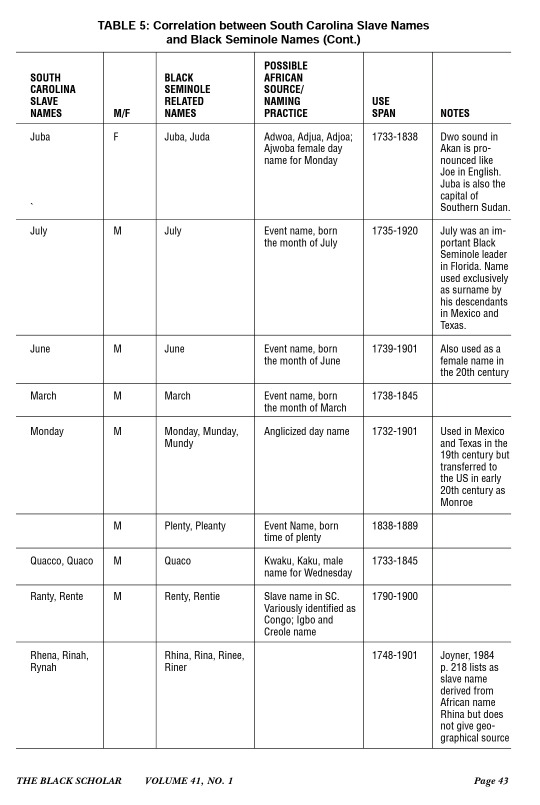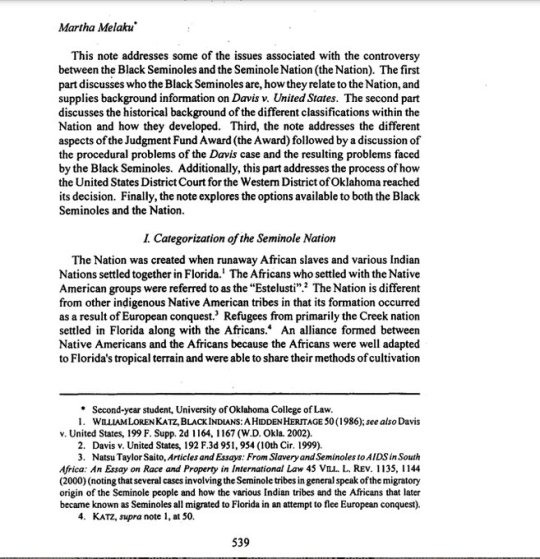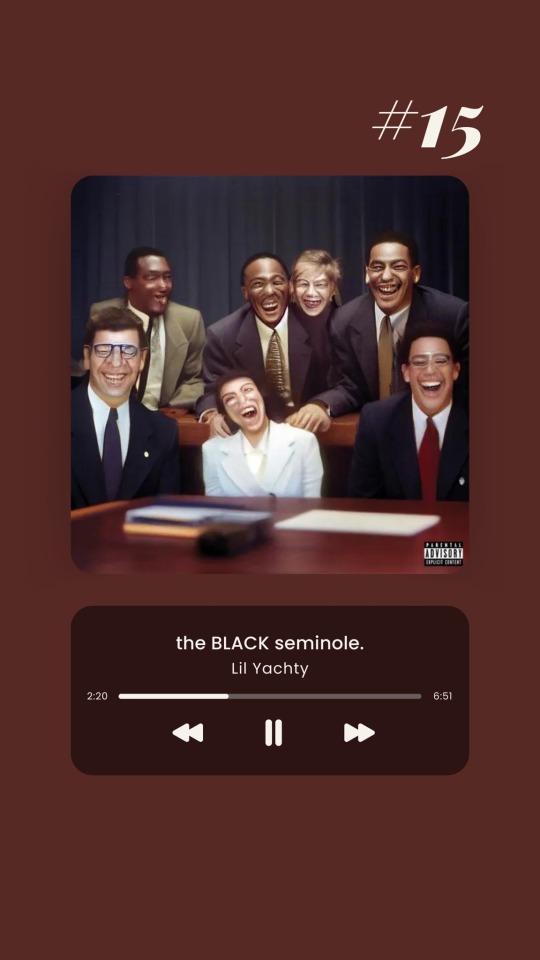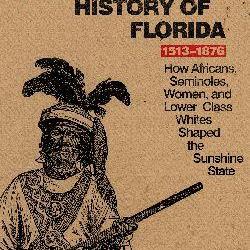#the BLACK seminole.
Text
147 notes
·
View notes
Text




“my body not yours”
photo credit: treehouse media - joshua franzos
#central flow#central flow Roxanne#Roxanne in all leather#are we still breathing?#witchblr#green witch#alternative rock music#alternative black girl#alt black girls#body autonomy#lgbtq icons#black witch#black goth#indigenous#indigenous art#choctaw#cheroenhaka#seminole#gothic fashion#southern gothic#alt rock#alt model#black cowboys#black cowgirl
66 notes
·
View notes
Text
Lil Yatchy’s album Lets Start Here is a masterpiece and belongs in my hall of fame.
#don’t talk to me until you have listened to the BLACK seminole. and those guitar riffs#specifically 2:16#musiq
7 notes
·
View notes
Video
youtube
The Black American Tribe They Tried to Hide
They beat the US, burned down their captors plantations, walked the Trail of Tears, forced their own emancipation and then settled in Mexico. This is the fantastic tale of the Black American Tribe to beat them all enjoy!
#youtube#The Black American Tribe They Tried to Hide#Seminoles#Black Native American Tribes#Black Gods
5 notes
·
View notes
Text
If the Black Seminoles were Indians, why did they speak African Creole & had African names?




youtube
#If the Black Seminoles were Indians#why did they speak African Creole & had African names?#Africans#Freedmen#Indians#cherokees#Black Seminoles#Youtube
15 notes
·
View notes
Photo

Faith Banks (Florida State)
#faith banks#florida state university#florida state seminoles#college athletes#training#black women#butt#athletics#ncaa#track and field
21 notes
·
View notes
Text
Witty Cudjoe
It's Black History Month in the United States, and I want to share the story of my 3rd Great Grandfather, Witty Cudjoe.
Born in 1830 during the Seminole Wars in Florida, Witty Cudjoe shared his memories in a newspaper article published when he turned 105. Witty's heritage is a legacy of warriors, tracing back to his grandfather, King Cudjo.
King's journey from slavery in the Carolinas to freedom in Spanish Florida in the 1700s marked the beginning of a lineage that shaped the Seminoles. Witty's father and grandfather fought alongside fellow Seminoles, facing Andrew Jackson and the United States Army.
Witty also discussed the removal to Indian Territory after a deceptive treaty with the United States. Despite being initially enslaved, Witty later fought as a Loyal Seminole, securing his freedom. He helped in the establishment of Wewoka, emerging as an important figure in his community.
During a time marked by the exploitation of Native Americans, Witty and his wife Mariah faced attempts to manipulate them out of their land allotments. Despite being unable to read or write, Witty took legal action and won, a remarkable feat at the time.
Witty's courage and determination defined his story, blessing future generations through the land he secured. Despite challenges posed by statehood, Witty leased 10 acres of his land to establish a school, preserving the Muscogee language and Seminole culture for his children. Witty lived to the age of 116, passing away in 1946.
During my last visit to Oklahoma, I met a 94-year-old cousin who had cared for Witty in his later years. Hugging her felt like reaching back through time, expressing gratitude to Witty for my existence.
Reflecting on our history, I see similarities with other communities, such as the Palestinians fighting for freedom. Like the Palestinians, they too faced forced displacement and theft of identity. Despite everything, our ancestors stood strong, and our community perseveres.
In solidarity with the Palestinian community, I commemorate Black History Month, acknowledging shared struggles. I hope that by standing together, we can illuminate the path home for all displaced people someday.





6 notes
·
View notes
Photo

(via Nacimiento De Los Negros: The Afro-Mexican Town That Celebrates Juneteenth - Travel Noire)
12 notes
·
View notes
Text


If this were a list ranking best opening tracks of the year, the BLACK seminole might just have taken it. Sonically it represents a huge left turn for Yachty, and it also happens be really enjoyable.
Playlist:
#music reviews#new music#soty#2023 music#hiphop#psych rock#alt rock#electro funk#lil yachty#the black seminole#Spotify
2 notes
·
View notes
Text
is anyone here Seminole from the South East region of the US? i am Gullah Geechee and our people have a tied history.
for example we fought a war against white settler colonialists as allies in the Gullah Wars that took place in South Carolina and Florida (you may know the Florida half of it as the "SeminoleWars")
more here:
https://twitter.com/geecheesociali1/status/1254956622062989317
my friend wrote it. it is unfortuneatly on twitter so you would need an account.
there is not a lot of free information available on it from the Gullah pov ime.
i am curious about any shared characteristics or practices we have. i am from South Carolina and so is 3/4ths of my family, and the other 1/4 of my family is from from Florida. i don't know them too well due to deaths, but they look like me and also integrate spanish among other things. we (Gullah and Seminole) people had a settlement in (”Spanish”) Florida.
we have intermixed but idk how to feel totally because some of us were kept as slaves by the Seminole. we have mixed history, good and bad. let’s chat and build/mend a bridge :)
i've never done any DNA testing, but that's not what I am after here. I just would like to have a cultural exchange, and listen to your history of the events etc. build some bridges in respect to our those of our ancestors who built bridges too. also, my Floridian Descendent of Slavery, Gullah sounding, Spanish patois speaking, family is a little lost to me. if this is you, or you know more, i'd love to be a little less lcultually separated in that regard.
#Seminole#gullah geechee#Indigenous#Black Seminole#Seminole Wars#Florida#i get white people often claim to be indigenous but i think this is different for a lot of reasons#all links that aren't twitter go to mastodon
4 notes
·
View notes
Video
youtube
Lil Yachty - the BLACK seminole
Sex symbol, the Black Seminole
A sex symbol, the Black Seminole
African Rambo with more ammo
Can't be escaped, I'm on every channel
What's wrong? What's wrong, Mr. Man?
Your eyes are low
And you're walking with both hands on your head
His response, he's on a clean, clean high
Both feet up on the ground
But his head's way, way, way in the sky
The Black Seminole, a head general
Distant connections, a large interval
A black man with mouths to feed
Embracing equality throughout greed
No time to joke around, the kid is now a man
And the silence is filled with remarkable sounds
This part I've seen in my dreams
Love is not a lie, it just feels like a Tarantino movie scene
Now
Ooh, ooh-ooh, ooh
Mm-mm-mmm, ooh
Ah-ha, aaah, yeah-hey, yeah
17/05/2023
2 notes
·
View notes
Video
youtube
Black Seminoles: A Nation Divided-
A Nation Divided - Indian tribes across the country are reaping windfall profits these days, usually from gambling operations. But some, like the Seminole Nation of Oklahoma, are getting rich from belated government payouts for lands taken hundreds of years ago. Now, the government is paying the tribe $56 million for those lost Florida lands, and the money is threatening to divide a nation. CBS News, "60 Minutes" July 10, 2002
6 notes
·
View notes
Text
youtube
When the Seminole Indians Aligned With Escaped Slaves
The Black Seminoles were a group of people that history, for the most part, forgot about. Their alliance with the native Seminole tribes resulted in a unique relationship that had never been seen before, and that changed the course of history for both the Seminoles and the State of Florida as a whole.
The Black Seminoles, sometimes called Maroons, were a group of freed men and runaway slaves living in Florida during the mid-16th century. They settled the first free Black town in American history, attained their freedom by joining the Spanish and converting to Catholicism, and formed a tight cultural bond with the Seminole tribes.
#When the Seminole Indians Aligned With Escaped Slaves#Freedmen#florida#Seminoles#Black Indians#Black History Matters#Black History of Florida#Black History Month 2024#bhm24#2024#Youtube
6 notes
·
View notes
Text
The "Negro Fort" massacre | libcom.org

This article is an excerpt of Wasserman's A People's History of Florida.
The Patriots War, the War of 1812, the Creek War, and the Seminole War were all closely interrelated conflicts, revolving around Indian Removal and slavery. The fighting in the U.S. Southeast during the second decade of the 19th century defined Manifest Destiny, which was underlined by a disposition to expand slavery and white supremacy. Manifest Destiny was the self-declared right of the United States to violate national sovereignty to eliminate any perceived threat of an encroaching foreign colonial power in its vicinity. This policy also intended to seize Spanish colonial possessions and annex them in order so the South could procure additional slave states. Indian Removal and slavery were combined with Manifest Destiny in the war of 1812 as British agents utilized disaffected native tribes and fugitive slaves to form a Southern front against the United States.
The wars in the Southeastern United States were all characterized by the same predisposition of U.S. expansionism – which itself was characterized by attempts to expand and protect slavery. The reigning U.S. doctrines of the early 19th century came about in opposition to the threat that slave and native sanctuaries like Florida posed to the Southern states. As the policies of Indian Removal and Manifest Destiny became more defined in the Southern theater of war, the free black and native settlements found themselves in a constant conflict with the slave-raiding, land-grabbing white settlers of Georgia.
After their defeat at Horseshoe Bend in the Creek War, the Red Stick Creeks fled into Florida to avoid Jackson’s draconian terms of surrender. Jackson’s military intervention in Florida partially focused on further destroying the anti-white Red Sticks Creeks that were incorporated into the Seminole and black settlements. As with the fugitive blacks, they grew to hold considerable power in the Seminole tribe, eventually enveloping the old chiefs.
In the war of 1812, the British used Florida as their base of operations to create a Southern front against the U.S. military. Florida was a diversion from the war in a North. British agents promised thousands of natives and fugitive blacks land, freedom, and protection as long as they fought on the British side in the war. The Seminoles, Miccosukees, Red Stick Creeks, and blacks established closer ties in these frontier operations, with the further understanding that they all shared a mutual interest to fend off the encroaching white settlers.
In 1814, British military official Col. Nichols ordered his Red Stick Creek allies to construct a fort on the Appalachicola River. The British retreated from their position at Pensacola after Andrew Jackson’s invasion. They were joined by their Red Stick Creek allies and several hundred slaves belonging to the residents of that town. 1 Nichols furnished the fort with artillery and munitions. The fort was located fifteen miles above the mouth of the river, manned with three hundred British soldiers and an immediate flow of refugee Seminoles and runaway slaves from Southern states who sought the protection of the British military and arms to defend their lands from white settlers. 2 The purpose of the fort was to assemble an army of disaffected indigenous people and runaway slaves to attack the white settlements on the southern Georgia/Alabama borders. By December 1814, over 1,400 warriors gathered at the fort – a coalition of refugee Red Stick Creeks, Seminoles, blacks, and numerous tribes indigenous to Florida. 3 General Gaines estimated 900 warriors and 450 armed blacks inhabited the fort. 4 The runaway slaves were given the opportunity to either leave for the British colonies to receive land as free settlers or fight under the British military. 5 By the early summer of 1815, Nichols left the Appalachicola for England accompanied by a handful of Red Stick Creek chiefs. He intended on making their cause known to the British Crown in hopes for protection against the Americans. The Red Stick Creeks and Seminole warriors who remained behind abandoned the fort soon afterwards. 6
Before Nichols had even left, the blacks had already taken possession of the fort. An additional 300 to 400 runaways were estimated to have fled to the fort for protection. 7
A letter from General Gaines on May 14th declared: “Certain Negroes and outlaws have taken possession of a Fort on the Appalachicola River in the territory of Florida.” 8
The Seminoles “were kept in awe” at the hundreds of armed blacks in the vicinity. “For a period,” William H. Simmons claimed, the Seminoles “were placed in the worst of all political conditions, being under a dulocracy or government of slaves.” 9
Nichols left behind a large supply of arms, artillery, and ammunition to protect the inhabitants from slave raiders and to commission raids on Southern plantations. They were supplied with 2,500 stands of musketry, 500 carbines, 500 steel scabbard swords, four cases containing 200 pistols, 300 quarter casks of rifle powder, 162 barrels of cannon powder, and a large count of military stores. On the walls of the fort were mounted four long twenty-four pounder cannon, four long six-pounder cannon, a four-pound field pierce, and a five and a half inch howitzer. 10
The fort grew from a strategically defensive base to a flourishing free black community around the banks of the Appalachicola. The blacks cultivated fields and plantations extending fifty miles up the river. Many of the black Seminoles were descendents of West Africans. They inherited generations of knowledge of African agricultural techniques. The community surrounding the fort was attractive for its defensible position and cultivatable lands. Runaway slaves were pouring in on a daily basis. The community grew to about 1,000 blacks in the fields surrounding the fort. 11
A total 300 black men, women, and children were in possession of the fort, accompanied by about twenty Choctaws and a number of Seminoles. 12
Joshua Giddings vividly depicted the “Negro Fort”:

“Their plantations extended along the river several miles, above and below the fort. Many of them possessed large herds of cattle and horses, which roamed in the forests, gathering their food, both in summer and winter, without expense or trouble to their owners. The Pioneer Exiles from South Carolina had settled here long before the Colony of Georgia existed. Several generations had lived to manhood and died in those forest-homes. To their descendants it had become consecrated by “many an oft told tale” of early adventure, of hardship and suffering; the recollection of which had been retained in tradition, told in story, and sung in their rude lays. Here were graves of their ancestors, around whose memories were clustered the fondest recollections of the human mind. The climate was genial. They were surrounded by extensive forests, and far removed from the habitations of those enemies of freedom who sought to enslave them; and they regarded themselves as secure in the enjoyment of liberty. Shutout from the cares and strifes of civilized men, they were happy in their own social solitude. So far from seeking to injure the people of the United States, they were only anxious to be exempt, and entirely free from all contact with our population or government; while they faithfully maintained their allegiance to the Spanish crown.” 13
Colonel Patterson wrote about the Appalachicola Fort:
“The force of the negroes was daily increasing; and they felt themselves so strong and secure that they had commenced several plantations on the fertile banks of the Appalachicola, which would have yielded them every article of sustenance, and which would, consequently, in a short time have rendered their establishment quite formidable and highly injurious to the neighboring States.” 14
The fort was becoming a growing threat to slavery itself. The existence of an autonomous free black community was intolerable alone, but it became a rallying point for runaway slaves fleeing from other Southern states. The blacks were less concerned about “committing depredations” as was depicted by U.S. military officials than they were about protecting their freedom.
As Giddings described, they were “happy in their own social solitude,” finally free and safe after decades of harassment and terror. They had the means for sufficient provisions with no reason to attack the frontier settlers. As much as the expansionists wished to depict them as outlaws they could not attribute them to even one instance of murder or theft. The crime they were guilty for was to “inveigle negroes from the citizens of Georgia, as well as from the Creek and Cherokee nations of Indians.” 15
Col. Patterson commended its elimination:“The service rendered by the destruction of the fort, and the band of negroes who held it, and the country in its vicinity, is of great and manifest importance to the United States, and particularly those States bordering on the Creek nation, as it had become the general rendezvous for runaway slaves and disaffected Indians; and asylum where they were assured of being received; a stronghold where they found arms and ammunition to protect themselves against their owners and the Government.” 16
As the blacks peacefully flourished in their isolated community on the Appalachicola, military officials and slaveholders planned its destruction. On May 21, a British “gentleman of respectability” from Bermuda wrote a memorandum disapproving Col Nichols for having “espoused the cause of the slaves.” He wrote of the “Negro Fort”: “No time ought to be lost in recommending the adoption of speedy, energetic measures for the destruction of a thing held so likely to become dangerous to the state of Georgia.” 17
On March 15, 1816 the Secretary of War ordered General Andrew Jackson to call attention to the governor of Pensacola to the fort. If the Spanish governor refused to “put an end to an evil of so serious nature,” the U.S. government would promptly take measures to reduce it. If the Spanish government was too weak to destroy it, then the U.S. was more than willing to take it into its own hands.
On April 23, Jackson transmitted the demands of Secretary Crawford, ordering the Spanish governor to “destroy or remove from out frontier this banditti, put an end to an evil of so serious a nature, and return to our citizens and friendly Indians inhabiting our territory those negroes now in said fort, and which have been stolen and enticed from them.”
The blacks at the Appalachicola Fort were supposedly “enticed from the service of their masters.” 18
Of course the runaways couldn’t have possibly been dissatisfied with a life of servitude. Jackson knew that the slaves were not actually stolen away.
They were runaways from slaveholders who sought refuge at the fort with the promise of abundance and freedom under the protection of the free blacks. Most of the black warriors and families had been free for generations.
Their ancestors had fled from their masters to Spanish Florida many decades before. Plus Jackson’s request to the Spanish governor only gave a façade of legitimacy to the inevitable designs of the U.S. government. On April 8, two weeks before Jackson wrote the Spanish governor, he ordered General Gaines to destroy the “Negro Fort” regardless of its location on Spanish territory:
“I have little doubt of the fact, that this fort has been established by some villains for rapine and plunder, and that it ought to be blown up, regardless of the land on which it stands; and if your mind shall have formed the same conclusion, destroy it and return the stolen Negroes and property to their rightful owners.” 19
General Gaines carefully prepared for the operation. He himself believed that the fort would “produce much evil among the blacks of Georgia, and the eastern part of the Mississippi territory.” 20
Obviously this terrible evil meant to leave their lifetime of bondage for a state of freedom. Lt. Col. Duncan Lamont Clinch was assigned to destroy the fort. Clinch had his own interests when it came to the fort, being among the most prosperous slaveholders of Florida. He undoubtedly felt that his profit interests were threatened by its continued existence. Gaines ordered him to speedily establish a fort near the junction of the Flint and Chattahoochee rivers, where they joined to form the Appalachicola, to intimidate the “Negro Fort.”
Clinch was to meet the convoy of supplies from New Orleans with fifty soldiers once he was informed that they had arrived at the river. The convoy was detached with two gunboats. From that point, Gaines ordered him to proceed to the “Negro Fort” where if he was to “meet with opposition” then “arrangements will immediately be made for its destruction.” Gaines wished to provoke an attack to justify the destruction of the fort. For this purpose, Clinch was supplied with two eighteen-pound cannons and one howitzer. 21
On July 10, the supply convoy reached the mouth of the Appalachicola where they received a dispatch from Col. Clinch ordering them to hold their position until he could arrive with troops to escort them up the river. On July 17, a party of five men from the supply vessels was sent to gather fresh water.
Once the party entered the river, they discovered a black man on the shore, near one of the plantations along the Appalachicola. As soon as they touched down on the shore, about forty blacks and Seminoles fired a volley of shots from their hidden position in the bushes. The black man on the beach served as a decoy to lure the small party into the ambush. Three of the men were immediately killed, one dove into the water and made it back to the convoy, and the other was captured. 22
On that same day, Col. Clinch commenced to the “Negro Fort.” He left with about 116 soldiers and incidentally met a party of slave-hunting Creeks led by Chief McIntosh. The Coweta Creeks numbered about 150. They had been hired by General Jackson to capture slaves in the Appalachicola - offered fifty dollars for every slave they seized and returned to their owner.
A council was held where the Creeks agreed to keep parties in advance and capture every black that they discovered. On the 19th, they caught a black Seminole in the vicinity heading to the Seminole chiefs with the scalp of one of the members of the party they ambushed. The blacks were attempting to garner the assistance of their Seminole allies.
The prisoner communicated the story of the ambush. On the 20th, Clinch proceeded with the Creek force over to the fort and came within gunshot range. It was impossible to destroy the fort without artillery.
They were forced to wait until the gunboats from the supply vessel arrived. McIntosh was ordered to surround the fort with a third of his force and maintain an irregular fire. The blacks fired artillery back but to no avail. On the 23rd, the Creeks demanded that the blacks surrender but they responded defiantly. The black commander Garcon told the deputation of Creeks “he would sink any American vessels that should attempt to pass it; and he would blow up the fort if he could not defend it.” 23
The blacks then hoisted the English Union Jack accompanied with the red flag over the fort. The blacks knew that surrender would only mean slavery so they would be no compromise. For the next several days the blacks opened fire whenever any troops appeared in their view.
On July 27, the gunboats approached the fort. The blacks opened fire when they entered into gunshot range. The gunboats fired back with some cold shots to get an idea of their real distance. The gunboats then fired “the first hot one,” made red-hot in the cook’s galley, which went screaming over the wall and into the fort’s magazine full of gunpowder. The fort completely exploded. Col. Clinch reported the horrific destruction:
“The explosion was awful, and the scene horrible beyond description. Our first care, on arriving at the scene of the destruction, was to rescue and relieve the unfortunate beings who survived the explosion. The war yells of the Indians, the cries and lamentations of the wounded, compelled the soldier to pause in the midst of victory, to drop a tear for the sufferings of his fellow beings, and to acknowledge that the great Ruler of the Universe must have used us as his instruments in chastising the blood-thirsty and murderous wretches that defended the fort.” 24
He gave a “divine justification” for the massacre in the official report. But he also wrote a far more descriptive alternative account of the event without involving God:
"The explosion was awful, and the scene horrible beyond description. You cannot conceive, nor I describe the horrors of the scene. In an instant lifeless bodies were stretched upon the plain, buried in sand and rubbish, or suspended from the tops of the surrounding pines. Here lay an innocent babe, there a helpless mother; on the one side a sturdy warrior, on the other a bleeding squaw. Piles of bodies, large heaps of sand, broken guns, accoutrements, etc, covered the site of the fort. The brave soldier was disarmed of his resentment and checked his victorious career, to drop a tear on the distressing scene." 25
The terrible explosion instantly killed 270 black men, women, and children within the fort, the rest being mortally wounded out of the total 330 residents. Only a few survived. The black commander Garson and the Choctaw chief somehow managed to survive the explosion. The Creeks sentenced them to death for the murder of the four U.S. soldiers. They learned that the blacks had tarred and feathered the captured soldier.
The Creeks immediately executed them afterwards. Some six of the blacks were captured and immediately returned to their speculated masters - that is if they were ever held in bondage at all. The large number of runaway slaves on the fields that surrounded the river scattered about to safety. Some fled to the protection of the blacks and Seminoles at the Suwannee and others left to the growing free black community just south of Tampa Bay.
The elimination of the fort was not the end of the black Seminole social structure in Florida. Several other black communities remained largely intact. But it was far from the end of the terror inflicted on the black Seminoles by the Federal government. It was far from the end of their resistance either. They would strive to avenge the loss of their family members and loved ones. 26
#Negro Fort#Seminoles#Creeks#Miccosukees#Black Enslaved#spanish#suwannee#appalachacola#florida#Black history of florida#freedmen#ft gadsden
3 notes
·
View notes
Text
The last community gets three articles for a very obvious reason:
Their existence not only shaped the definition of the USA's southern boundaries (and under the current Governor of Florida's system as such the beginning of Florida's history is now illegal to teach in the state), but did so in a way that helped to launch the career of one Andrew Jackson and touched off the longest Indian War in the Southern United States.
And the reasons for this were that Spanish power in Florida was fairly weak, US power in southern Georgia was weaker, and Maroons took advantage of obvious weaknesses to run away from slavery and built up a strong, well-armed community in alliance with the new Simanoli/Seminole people formed out of the shattered nations of Spanish power and the fall of the Mississippians.
For the so-called 'democrat', the existence of a Black and Indigenous alliance on the border of the Slave Power was an intolerable slight and it was his legacy that set in motion the annexation of Florida and three bloody wars to squelch it.
#lightdancer comments on history#black history month#black resistance#slavery and resistance#florida history#black history is florida history#fuck you ron desantis#seminole wars#black seminoles
2 notes
·
View notes
Text
anyway, back to this BOAT.
—
what was he ON?!
—
youtube
4 notes
·
View notes